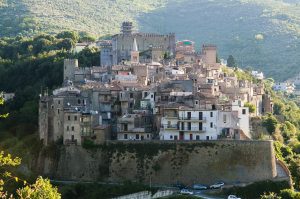Train and bikes
Condividi
This picturesque and fairly easy itinerary unfolds through rustic towns and artistic and monumental vestiges scattered throughout the countryside.

Once you leave Tivoli station, head towards Via Tiburtina until you reach Villa Gregoriana: this is a large public park created by Pope Gregory XVI in 1835, on the bed of the Aniene river which changed its course after the terrible flooding in 1823. By walking through the park, visitors can admire wonderful views of the cliffs in the valley, the waterfall precipice, the remains of the Roman villas, the ancient ponte Valerio and the aqueducts. In the lower part you come to the Cascata Grande falls (large waterfall) of 100 metres and then access the Nettuno and Sirene grottoes, created by the violence of the water. Once you leave the park, take your bicycles again and head towards the city across the ponte Gregoriano, a bridge built by Pope Gregory XVI in 1843. Once you have crossed the historic centre of the town, you will reach the Belvedereoverlooking the waterfalls; continue downhill along via Tiburtina for another 100 metres. Turn left onto via di S. Greogrio: here a rise begins which follows the hillside and offers views of the valley of the Aniene and reaches S. Gregorio da Sassola after several gradients. This small medieval town is, perhaps, the old Saxula, and is located in a strategic position on a spur of rock which saw many clashes and revolts against the domain of Roman noble families and the Pope.
The palazzo Brancaccio is a suggestive fortress with towers and a drawbridge, richly decorated inside with frescoes by Federico Zuccai. The small medieval town is picturesque, but the Borgo Pio is particularly interesting. This was built by Carlo Pio di Savoia to redevelop the town after the plague which struck the town in 1656. The borgo consists of five identical groups of houses which alternate with each other along a straight road which ends in an oval piazza, and is one of the first examples of a rational building plan carried out in the Church State
Once you leave S. Gregorio da Sassola, the path continues along a gentle rise among thick olive groves spread out on the colle degli Astinelli until it reaches Casape, a fortified town built around a castle dating back to the 11th century, which was then transformed into a noble residence in the Renaissance. Once you have left the town, the route becomes more undulated and reaches the interesting town of Poli; from here a steep descent starts which leads back to the Aniene valley. Once you reach the fork in the road for Corcolle, perhaps the old Querquetula mentioned by Pliny, follow the road towards Zagarolo and Valle Inversa until you reach the station of Lunghezza.
| By train: | Outward journey: Roma Tiburtina-Tivoli line Return: Lunghezza-Roma Tiburtina line |
| By bicycle: | Length: about 48 km Difficulty: average |
Information:
www.parchilazio.it
R. Pugliesi, Lazio. Treni & bici. Il Lazio Settentrionale, Padova 2000.